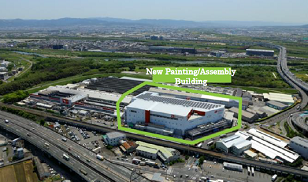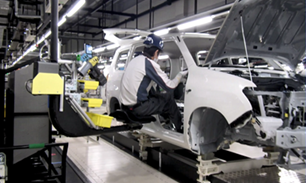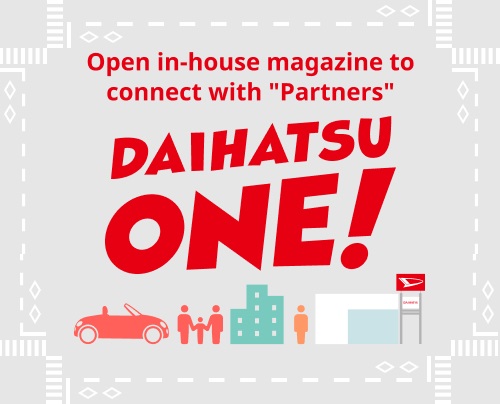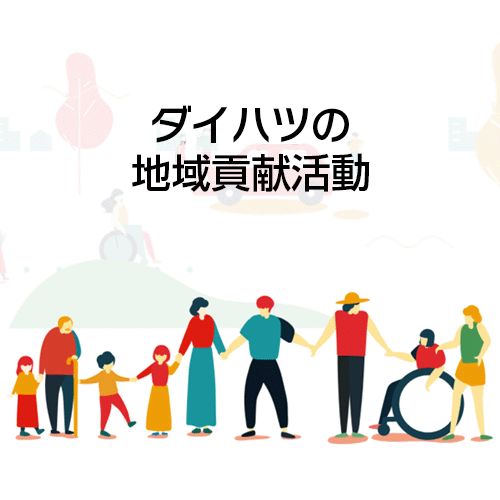- Company
- Management Policy & Strategy
- NEWOct. 07, 2022
Daihatsu Updates Kyoto (Oyamazaki) Plant Toward Carbon Neutrality ~Advancing SSC and starting full-scale operation as an environmentally- and people-friendly plant~
Oct. 07, 2022
Daihatsu Motor Co., Ltd.


Daihatsu Motor Co., Ltd. (hereinafter “Daihatsu”) announced today that it has updated its Kyoto (Oyamazaki) Plant toward carbon neutrality. The plant advances the implementation of Simple, Slim and Compact (SSC) and has started full-scale operation as an environmentally- and people-friendly plant. Safety prayer and completion ceremonies were held today.
The Kyoto (Oyamazaki) Plant began operations in 1973. It has produced a cumulative total of approximately 6.4 million units, mainly compact cars and vehicles entrusted by Toyota Motor Corporation. In September 2018, the Kyoto (Oyamazaki) Plant began a major update for the first time in about 50 years to maintain and improve competitiveness, and to become a next-generation plant where CO2 emissions are reduced and a diverse workforce can work comfortably.
The new plant pursues Daihatsu's MONODUKURI concept of SSC and implements thorough energy-saving measures. The painting and assembly processes have been consolidated in one newly constructed building. In addition, improvements such as the expanded use of SPS*1, which allows multiple people to work on one vehicle, and the shortening of process lengths through the traverse feeding of vehicles have been implemented. As a result, the number of processes has been reduced by approximately 15% compared to the previous plant and the time required to produce one vehicle has been shortened by approximately 30%. In addition, CO2 emissions have been reduced by approximately 42% compared to the previous plant through the use of new technologies, such as air conditioning recycling in dry booths at the paint plant and the use of solar energy.
Furthermore, with the aging of plant employees, Daihatsu has focused on creating people-friendly processes where everyone can work safely and with peace of mind. In the assembly process, tasks that place a physical burden on employees have been eliminated, such as tightening work while walking alongside or getting into vehicles. In the painting process, the plant has evolved to become an easier working environment for a diverse workforce by reducing the burden on workers, such as by expanding the automatic coating application scope of robots.
In addition, logistics in the transportation of finished vehicles have been reformed with the belief that the timely delivery of high-quality vehicles to customers will improve competitiveness.
*1 Abbreviation for Set Parts Supply System, a system in which parts for one vehicle are pre-set and supplied to the worker
Daihatsu will deploy the technology and know-how cultivated in this project both in Japan and overseas. It will also work toward realizing carbon neutrality in its plants by 2035 by promoting thorough energy-saving through the pursuit of SSC, the development and incorporation of innovative technologies, and the utilization of renewable energy. In addition, Daihatsu will also strive to make its Kyoto (Oyamazaki) Plant and all other plants beloved by the local community.
Overview of Kyoto (Oyamazaki) Plant
| Address | 1 Koaza Kitahosoike Aza Shimoueno, Oyamazaki-cho, Otokuni-gun, Kyoto |
|---|---|
| Established | April 1973 |
| Site area | Approx. 172,000 m2 |
| Total floor area | Approx. 42,000 m2 (newly constructed sections only) |
| Capital investiment | Approx. 35 billion yen (updating work only) |
| Number of employees | 1669 (before updating work: 885) *as of October 1, 2022 |
| Production capacity | 230,000 units (before updating work: 134,000 units) |
| Vehicles produced | Thor/Roomy/JUSTY, Boon/PASSO, Probox |
Main Points of Updating Work
1. Overall
- The painting and assembly/inspection processes, which were previously separated, have been consolidated in a newly constructed four-story building. It is a multi-story structure with the assembly/inspection process mainly on the first floor and painting process mainly on the second to fourth floors. Efficient heat management has been implemented by concentrating heat sources on the fourth floor to prevent heat leakage into work floors.
- Solar panels have been installed on the roof of the new building, supplying part of the electricity used at the plant.
- A production line that can flexibly respond to vehicle models and quantities has been realized through the expansion of general-purpose processes and other measures. In the body process, flexible changes in transfer routes have been made possible through reduced conveyer transfer of shell bodies and pressed parts and the expanded use of automatic transfer carts. In addition, in the assembly process, the conveyor is aboveground and power unit is no longer underground, enabling flexible changes in process length.
- The car distribution yard has been relocated to the site of the former paint factory. The yard has evolved into a compact yard that can handle a similar number of cars in half of the area of the previous yard by improving the way finished cars are transported. In addition, the layout has been changed to move it closer to the plant, contributing to shorter lead times. Furthermore, a large roof was added to the yard to make it easier for transporters to load vehicles when raining.
2. Painting Process
- Processes that were previously performed by hand, such as the painting of internal panels, have been changed to automatic application by robots to conserve manpower.
- New dry booth air-conditioned recycling technology has been adopted. Previously, uncoated paint from the painting process was collected using water. However, by changing to a compact device using cardboard filters, it has become possible to recycle air conditioning with the proper temperature and humidity. This has halved energy consumption and contributed to a reduction in water consumption.
- The number of particles scattered has been reduced through high paint application efficiency using electrostatic induction technology (electrostatically charged particles are attracted to the car body), contributing to reductions in paint and energy consumption.
3. Assembly/Inspection Process
- The use of SPS has been expanded and many of the parts required in each process are placed on SPS dollies and transported in batches, eliminating as many parts racks normally installed on the line side as possible. Multiple people are assigned to each vehicle to reduce processes and traverse feeding for the vehicle lifting process has been implemented. This has shortened the process length, reduced production lead time, and increased compactness.
- In order to create people-friendly processes, work that was performed while walking alongside a conveyor with the vehicle has been changed to a method that allows the vehicle and worker to assemble parts in sync. In addition, the burden on workers created by work done while riding in vehicles has been thoroughly reduced, such as by adopting an arm that allows work to be done while sitting in a chair.
- For large parts such as the powertrain (engine/transmission/etc.), instrument panels, seats, and HEV batteries, the method has been changed so that the vehicle stops at the U-turn on the conveyor and parts are mounted. This reduces the burden on workers and contributes to high quality manufacturing.
- Work orders are now written on tablets instead of paper. In addition, digitalization including the use of in-house AI and the introduction of a facial recognition system has been promoted, contributing to an easier working environment and improved quality.




